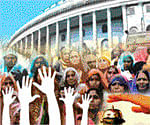Will women's reservation in Parliament become a reality?
As its winter session wound down last week, it was clear that the Indian Parliament would remain a male bastion for the near future.

The lower house, almost 90 percent male in its composition, had ensured that a bill intended to increase the number of female members would not be passed for at least another year. In March 2010, feminists and women’s organisations had celebrated the passage of the Women’s Reservation Bill in the upper house, after a fierce 13-year debate among political parties. It seemed then that a battle of some significance had been won.
The bill would amend the Constitution to reserve one-third of seats in Parliament and in state assemblies for women. Despite sometimes chaotic proceedings in the upper house, the final vote was nearly unanimous, with 191 votes for and one against. When it passed, Brinda Karat, a member from the CPM and a longtime campaigner for women’s rights, spoke for many when she said: “The bill will change the culture of the country, because women today are still caught in a cultural prison. We have to fight stereotypes every day.”
The numbers bear her out. India’s first Parliament had roughly 4.4 per cent women in the lower house. The framers of the Indian Constitution had assumed that the number of women would increase on its own, as the country developed. But the number of women MPs has remained low in the more than six decades since Indian independence.
The present Parliament, the 15th, has 59 women in the 545-seat lower house, or 10.8 per cent, and 24 women in the 242-seat upper house, or just short of 10 per cent. According to the Inter-Parliamentary Union, the Geneva-based international organisation of parliaments, the worldwide average of female representatives in national parliaments is 19.3 per cent, which places India at the lower end of the scale.
To take effect, the proposed amendment must be ratified by the lower house before being approved by at least half of state legislatures and the president. But what some had expected, after the 2010 victory, to be little more than a formality in the lower house has turned into yet another exhausting round of battles.
The primary opposition to the bill appears to come from the complexities of caste-based politics. An oft-repeated objection was summarised by Sharad Yadav, who in 2010 declared that the bill would “only help upper-caste elite women get elected.” The basic argument, made by political parties like the BSP, which represents mostly lower castes, and Yadav’s own JD(U), is that quotas for women will come at the expense of the disadvantaged and the Muslim minority.
Sacrifice of power
Many analysts, like the academic Zoya Hasan, would disagree. She wrote that “The most strident opposition to women’s quotas has come from male politicians who fear that their political careers would be put at risk.” Setting aside seats for women would require male members of Parliament to give up about 180 seats in the lower house – a substantial sacrifice of power in an institution that has seen female prime ministers and female speakers, but few female members.
Unlike members of the upper house, members of the lower house are directly elected and therefore more likely to be swayed by local electoral politics and caste, class and ethnic interests.
Although the debate over the bill focuses on the possible setbacks for disadvantaged castes, it rarely addresses whether quotas for women are of themselves desirable.
This might be in part because of what is widely considered the success of quotas for women at the village level, in what are known as the ‘panchayati’ elections. In an influential 2003 study, the economists Esther Duflo and Raghabendra Chattopadhyay examined how the experiment had worked.
“Despite the handicaps they may face in terms of education and prior experience, and the preconception of weak leadership, women have a real impact on policy decisions,” they concluded.
Female council heads, they found, tended to give higher priority than their male counterparts to issues like public health and education. The difference more women in Parliament might make could involve what issues are on the agenda, or more subtle differences in the working culture of the houses.
As 2012 begins, even the bill’s most ardent supporters acknowledge that India’s female members of Parliament have a battle on their hands. But some took heart from a statement made by Congress president Sonia Gandhi. As the winter session drew to a close, Sonia mentioned the Women’s Reservation Bill and pledged to fight for its eventual passage in the lower house.
The first female president of the Indian National Congress party, the poet-politician Sarojini Naidu, would have approved. As a young leader of India’s independence movement, Ms Naidu was among a score of women who campaigned for the right to vote. It took them from 1917, when the Congress party backed women’s sufferage, to 1926, when women could vote and run for some state legislatures, to see the first changes, and then several more years before all women in India had the right to cast ballots.
“I am only a woman,” Ms Naidu said disarmingly, as she began a 1917 speech to the chiefly male stalwarts of the Congress. Nine years later, she had what she wanted: the right for women to vote along with the men. It had taken, like most political victories in India for women, a great deal of time and patience.
Deccan Herald is on WhatsApp Channels| Join now for Breaking News & Editor's Picks